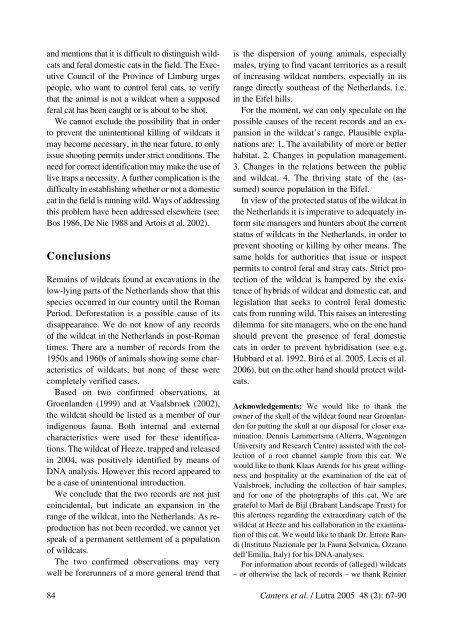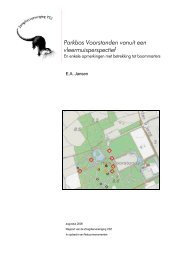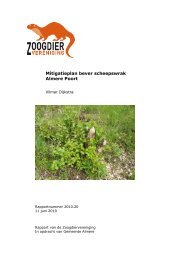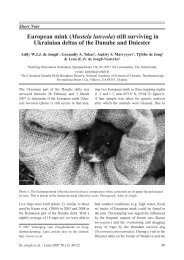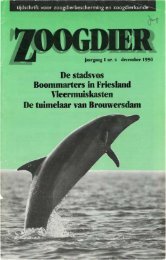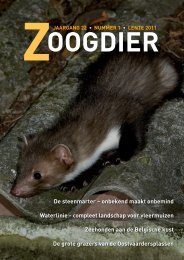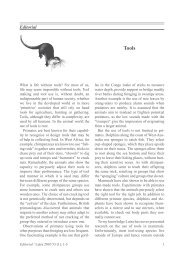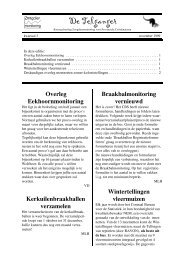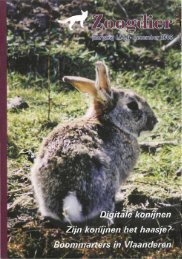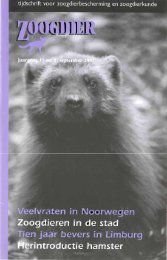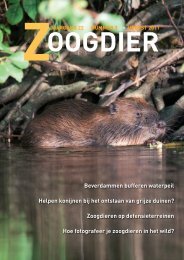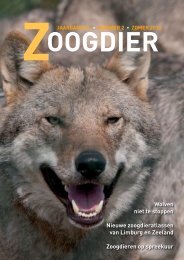binnenwerk 48-2-2005 - De Zoogdiervereniging
binnenwerk 48-2-2005 - De Zoogdiervereniging
binnenwerk 48-2-2005 - De Zoogdiervereniging
Create successful ePaper yourself
Turn your PDF publications into a flip-book with our unique Google optimized e-Paper software.
and mentions that it is difficult to distinguish wildcatsand feral domestic cats in the field. The ExecutiveCouncil of the Province of Limburg urgespeople, who want to control feral cats, to verifythat the animal is not a wildcat when a supposedferal cat has been caught or is about to be shot.We cannot exclude the possibility that in orderto prevent the unintentional killing of wildcats itmay become necessary, in the near future, to onlyissue shooting permits under strict conditions. Theneed for correct identification may make the use oflive traps a necessity. A further complication is thedifficulty in establishing whether or not a domesticcat in the field is running wild. Ways of addressingthis problem have been addressed elsewhere (see:Bos 1986, <strong>De</strong> Nie 1988 and Artois et al. 2002).ConclusionsRemains of wildcats found at excavations in thelow-lying parts of the Netherlands show that thisspecies occurred in our country until the RomanPeriod. <strong>De</strong>forestation is a possible cause of itsdisappearance. We do not know of any recordsof the wildcat in the Netherlands in post-Romantimes. There are a number of records from the1950s and 1960s of animals showing some characteristicsof wildcats, but none of these werecompletely verified cases.Based on two confirmed observations, atGroenlanden (1999) and at Vaalsbroek (2002),the wildcat should be listed as a member of ourindigenous fauna. Both internal and externalcharacteristics were used for these identifications.The wildcat of Heeze, trapped and releasedin 2004, was positively identified by means ofDNA analysis. However this record appeared tobe a case of unintentional introduction.We conclude that the two records are not justcoincidental, but indicate an expansion in therange of the wildcat, into the Netherlands. As reproductionhas not been recorded, we cannot yetspeak of a permanent settlement of a populationof wildcats.The two confirmed observations may verywell be forerunners of a more general trend thatis the dispersion of young animals, especiallymales, trying to find vacant territories as a resultof increasing wildcat numbers, especially in itsrange directly southeast of the Netherlands, i.e.in the Eifel hills.For the moment, we can only speculate on thepossible causes of the recent records and an expansionin the wildcat’s range. Plausible explanationsare: 1. The availability of more or betterhabitat. 2. Changes in population management.3. Changes in the relations between the publicand wildcat. 4. The thriving state of the (assumed)source population in the Eifel.In view of the protected status of the wildcat inthe Netherlands it is imperative to adequately informsite managers and hunters about the currentstatus of wildcats in the Netherlands, in order toprevent shooting or killing by other means. Thesame holds for authorities that issue or inspectpermits to control feral and stray cats. Strict protectionof the wildcat is hampered by the existenceof hybrids of wildcat and domestic cat, andlegislation that seeks to control feral domesticcats from running wild. This raises an interestingdilemma for site managers, who on the one handshould prevent the presence of feral domesticcats in order to prevent hybridisation (see e.g.Hubbard et al. 1992, Biró et al. <strong>2005</strong>, Lecis et al.2006), but on the other hand should protect wildcats.Acknowledgements: We would like to thank theowner of the skull of the wildcat found near Groenlandenfor putting the skull at our disposal for closer examination.<strong>De</strong>nnis Lammertsma (Alterra, WageningenUniversity and Research Centre) assisted with the collectionof a root channel sample from this cat. Wewould like to thank Klaas Arends for his great willingnessand hospitality at the examination of the cat ofVaalsbroek, including the collection of hair samples,and for one of the photographs of this cat. We aregrateful to Mari de Bijl (Brabant Landscape Trust) forthis alertness regarding the extraordinary catch of thewildcat at Heeze and his collaboration in the examinationof this cat. We would like to thank Dr. Ettore Randi(Instituto Nazionale per la Fauna Selvatica, Ozzanodell’Emilia, Italy) for his DNA-analyses.For information about records of (alleged) wildcats– or otherwise the lack of records – we thank Reinier84 Canters et al. / Lutra <strong>2005</strong> <strong>48</strong> (2): 67-90


